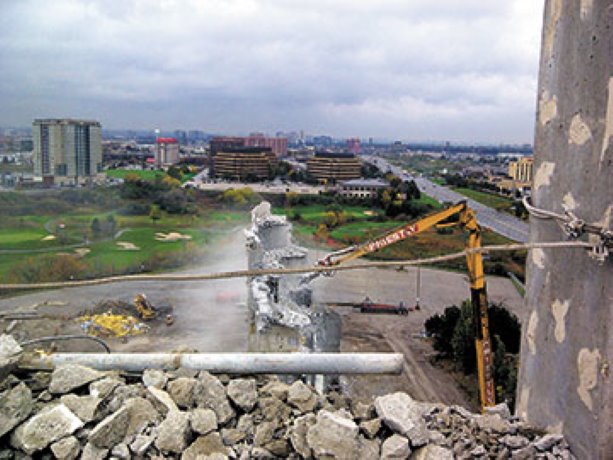The term “paradoxical” might be the only term to describe the complexities Priestly Demolition faced in demolishing the landmark Regal Constellation Hotel in Toronto’s airport strip.
On one hand, the task of tearing down two 15-storey towers and a third eight-storey building “was business as usual, no different than any others we have done,” says safety manager Jonathan Zuber.
“But not too many demolitions occur near an airport,” says Zuber, pointing out the demolition activity had to conform to Transport Canada’s stringent airspace standards which are meant to protect aircraft landing at nearby Pearson International Airport.
Not being the first contractor on site was another challenge. At one time, the 1960s era facility was a popular hotel and convention centre. With a change in ownership, the Regal was slated for demolition and that work got underway a few years ago. But then the original contractor suddenly departed the site, says Zuber.
With yet a new change in ownership, Priestly was hired to complete the project. But it wasn’t an easy task.
“It took us two weeks just to get to starting point (of the demolition).”
Several unsafe areas had to be secured and stockpiles of hazardous materials left by the first contractor had to be properly disposed off. Workers were also confronted with a maze of left-over hotel material such as old mattresses, numerous gas cylinders and rows of paint cans.
“There was nowhere to walk. In a normal demolition it (the material) would have already been removed.”
The sequenced remediation and demolition of the three structures also had its special challenges.
With a 12-storey limitation on a high-reach demolition excavator, mobile demolition equipment had to be lifted by a mobile crane to the top of one of the 15-storey towers. Reaching the highest floors of the second building wasn’t a problem because of higher ground on one side, says Zuber.
There was plenty of room for the cranes and other machines to manoeuvre as the hotel was situated on a sprawling site, he says.
But the original tower fronted on busy Carlingview Drive and almost right in front of the main entrance was a bus stop. To protect the bus riders, the contractor suspended a metal curtain down the entire façade, as well as erecting the standard hoarding.
“Not one pebble hit the hoarding,” says Zuber, attributing that achievement to both the curtain and the professionalism of the high-reach excavator operator.
But the most complicated aspect of the project was the Transport Canada standard, known as Canadian Aviation Regulation Standard 621. The 15-storey towers were equipped with rooftop warning lights for aircraft and those lights could never be turned off or Priestly would have faced stiff penalties.
“How do you shut off the power to keep your workers safe and still maintain the safety lights?”
In answering his own question, Zuber explains that an emergency power line was extended down the side of one of the buildings. This remedy wasn’t required on the second building because the electrical feed for the lights was in the elevator core.
Still, as demolition progressed downward from the rooftop, the lights had to be carefully relocated to the floors below. A key event in the project occurred on the day the structures were pulled down below the height limit restriction and the contractor no longer had to worry about the lights, says Zuber.
Approximately 50 to 60 workers were on site. These included 25 to 30 asbestos abatement workers, 10 to 15 demolition workers and anywhere from 10 to 15 heavy equipment operators.
The $3.2 million, three-month demolition was completed just before Christmas of 2011, with the contractor achieving a 100-per-cent waste diversion on the steel and concrete. After the concrete was crushed on site it was used to fill in the voids in what is now a large parking spot, says Zuber.
“This was a good job for us and went really well.”
But the project is far from complete, as remediation of the soil is still underway, he says.
The project manager is Urbacon and the consultant is Golder Associates.




Recent Comments
comments for this post are closed